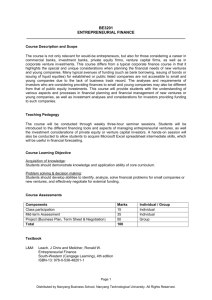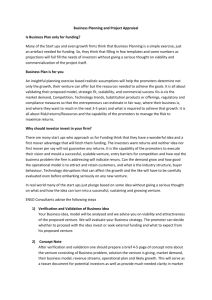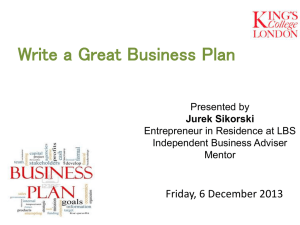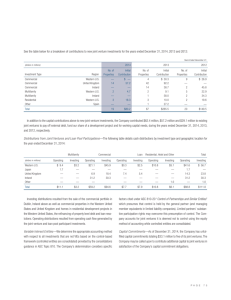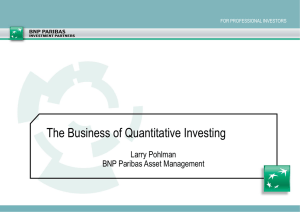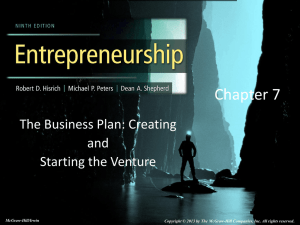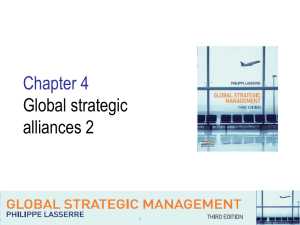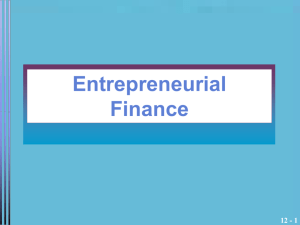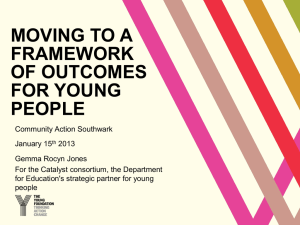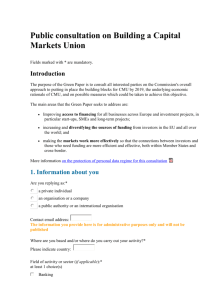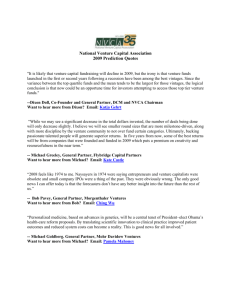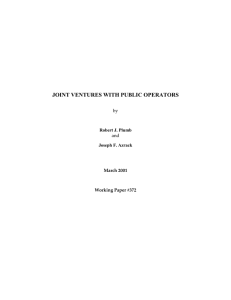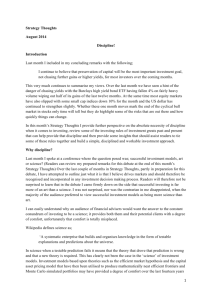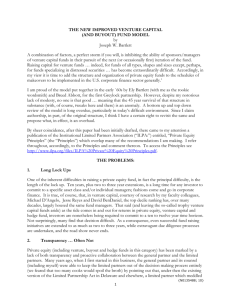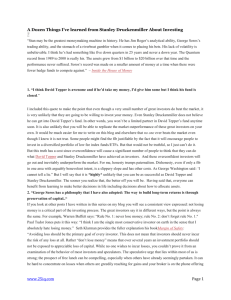The Honesty Box
advertisement
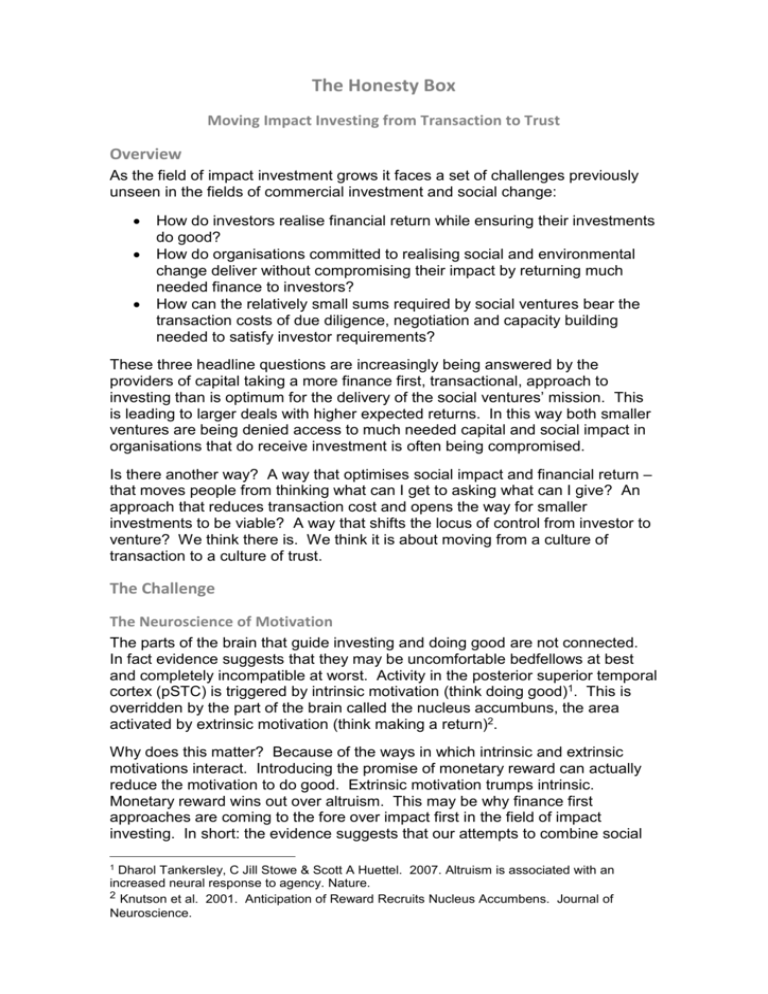
The Honesty Box Moving Impact Investing from Transaction to Trust Overview As the field of impact investment grows it faces a set of challenges previously unseen in the fields of commercial investment and social change: How do investors realise financial return while ensuring their investments do good? How do organisations committed to realising social and environmental change deliver without compromising their impact by returning much needed finance to investors? How can the relatively small sums required by social ventures bear the transaction costs of due diligence, negotiation and capacity building needed to satisfy investor requirements? These three headline questions are increasingly being answered by the providers of capital taking a more finance first, transactional, approach to investing than is optimum for the delivery of the social ventures’ mission. This is leading to larger deals with higher expected returns. In this way both smaller ventures are being denied access to much needed capital and social impact in organisations that do receive investment is often being compromised. Is there another way? A way that optimises social impact and financial return – that moves people from thinking what can I get to asking what can I give? An approach that reduces transaction cost and opens the way for smaller investments to be viable? A way that shifts the locus of control from investor to venture? We think there is. We think it is about moving from a culture of transaction to a culture of trust. The Challenge The Neuroscience of Motivation The parts of the brain that guide investing and doing good are not connected. In fact evidence suggests that they may be uncomfortable bedfellows at best and completely incompatible at worst. Activity in the posterior superior temporal cortex (pSTC) is triggered by intrinsic motivation (think doing good)1. This is overridden by the part of the brain called the nucleus accumbuns, the area activated by extrinsic motivation (think making a return)2. Why does this matter? Because of the ways in which intrinsic and extrinsic motivations interact. Introducing the promise of monetary reward can actually reduce the motivation to do good. Extrinsic motivation trumps intrinsic. Monetary reward wins out over altruism. This may be why finance first approaches are coming to the fore over impact first in the field of impact investing. In short: the evidence suggests that our attempts to combine social 1 Dharol Tankersley, C Jill Stowe & Scott A Huettel. 2007. Altruism is associated with an increased neural response to agency. Nature. 2 Knutson et al. 2001. Anticipation of Reward Recruits Nucleus Accumbens. Journal of Neuroscience. impact and financial return, while intellectually appealing, are impeded by physiological and psychological factors that are incredibly difficult to overcome. This neuroscience based explanation is congruent with the reality that in social investment it is the investor who defines the parameters of engagement, thus ensuring social impact is debated within a financial context. But what if we could subordinate activity in the nucleus accumbuns to that in the pSTC and so place finance squarely at the service of impact? Give and Take Studies have shown that when people are motivated by generosity the financial performance of the interaction they are engaged can increase. In a famous study professor Leif Nelson from University of California’s Haas Business School trebled the income from ticket sales at a museum by allowing people to pay what they wanted for entry, not for themselves but for the next visitor3. In a 2000 study in Israel, researchers offered subjects the opportunity to earn money for a charity at varying levels of financial reward for responding to a simple time reaction game. Across the board, when subjects were offered small rewards (around 1.5 pence), they answered incorrectly more often than when they were offered no rewards at all. Some subjects did perform slightly better in response to larger rewards, but not in proportion to the increase4. So why is it that impact investing, while trying to do good in the world, is utilising a mechanism that apparently neither optimises social or financial return? The Hypotheses This project’s working hypothesis is that by passing responsibility for setting financial performance metrics to the venture extrinsic motivations will be placed in a subsidiary position to the ventures objectives to do good in the world. In this way the transactional, financed focus, culture at the centre of impact investing would be replaced by a culture borne out of realising intrinsic motivation through developing a relationship of trust. Secondary hypotheses in this project are that: 3 In doing this, through developing this relationship of trust, investors will become more intrinsically motivated and be able to align their intrinsic and extrinsic motivations better; By inverting the locus of control, deal transaction costs will reduce thereby allowing both investor and venture to acknowledge lower rates of financial return; and Through the creation of a relationship of trust both parties will be able to price the deal on the basis of success rather than on the basis of failure, which will further drive down return expectations and open up the flow of capital to smaller and higher social impact projects. http://newscenter.berkeley.edu/2013/11/26/pay-it-forward/ and http://selfawarenessforchange.wordpress.com/2012/06/07/challenging-the-selfishnessparadigm/ 4 U. Gneezy & A. Rustichini. 2000. Pay enough or don’t pay at all. The Quarterly Journal of Economics. The Experiment To test these hypotheses we are calling for existing investors to commit to at least one deal using the following methodology: 1. Develop a relationship of deep trust with the leader and senior management of a social venture needing investment; 2. Subordinate all traditional due diligence requirements to this relationship and place the responsibility for all negotiations and due diligence within the bounds of this relationship onto the venture; 3. Use this relationship to decide if the lead person / people have the integrity, aptitude and capabilities to succeed and honour your investment; 4. Commit to funding the venture and pass all decision making about financial returns, timescale for returns, whether debt or equity investment, etc. to the venture; and then 5. Be present as a trusted friend of the venture and available to them whenever they ask and for the duration of the investment. We ask that both investors and ventures record their experiences qualitatively in a periodic journal as well as record the time and cost taken to develop the relationship, undertake the deal and then service the relationship and investment over its lifetime. This will allow us to capture the experience, measure the cost and value and test the above hypotheses. If the hypotheses are correct then this approach could set the standard for how to utilise trust to invest for impact and solve, at least for some investors, the challenges captured at the beginning of this paper. As of December 2013 two funds have committed to making investments in early 2014 using this approach. Some level of resourcing is needed to attract additional investors to adopt this approach and undertake the monitoring and evaluation of this initiative. To discuss this initiative, as a potential investor willing to adopt this methodology or as a funder of project management, please contact Ben Metz at mail@benmetz.org. Acknowledgement goes to Nipun Mehta, one of the inspirations behind ServiceSpace and Karma Café, for inspiration and the gifting of language to this initiative (http://www.youtube.com/watch?v=kpyc84kamhw).
